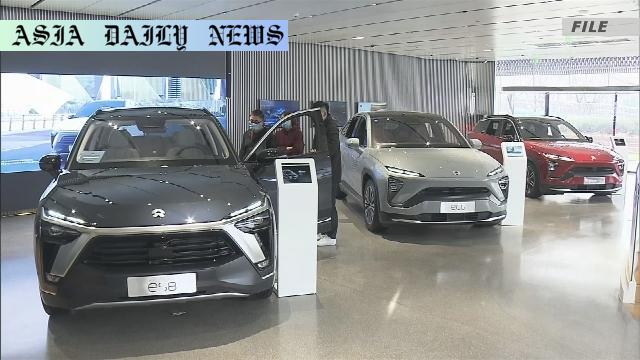Vehicle Sales: New-energy cars drive China’s May sales increase, with exports and domestic demand thriving amid rising competition.
- Vehicle Sales rise for the fourth month in China, driven by strong demand.
- Electric and new-energy cars report a 37% growth rate, dominating the market.
- Trade-in incentives offered by the government fuel market performance.
- Exports, including gasoline car shipments, see a year-on-year increase of 14.5%.

China’s Growing Vehicle Market Defies Expectations
New vehicle sales in China maintained an upward trajectory for the fourth consecutive month in May, reflecting strong market performance across diverse segments, especially electric and other new energy vehicles (NEVs). According to the China Association of Automobile Manufacturers, vehicle sales rose by 11.2% year-on-year to 2.68 million units. This steady growth is a testament to the rising demand for cleaner and more efficient cars in the world’s largest automotive market. As the market tilts toward sustainability, electric vehicles (EVs), plug-in hybrids, and fuel-cell models have witnessed a surge of nearly 37%, significantly impacting the automotive landscape.
The record-breaking performance stems largely from strategic trade-in incentives offered by the Chinese government, which encouraged consumers to upgrade to fuel-efficient and environmentally friendly vehicles. This has not only benefited the local economy but also positioned China firmly on the path to reducing its carbon footprint. Notably, exports of vehicles, including conventional fuel-powered cars, rose by 14.5% to reach 551,000 units, further solidifying the country’s dominant status as an epicenter of automotive innovation and manufacturing.
Electric Vehicle Boom: Leading the Drive Towards Sustainability
The NEV category has emerged as a crucial driver in the rising sales figures. Accounting for 48.7% of total vehicle sales, this segment underscores consumers’ increasing preference for sustainable alternatives. With advancements in battery technology, accelerated production, and competitive pricing, these vehicles have swiftly gained traction in the domestic market. Moreover, Chinese brands are aggressively competing with global players, adding pressure to reduce costs while maintaining quality. Despite hurdles such as price wars and global trade tensions, the domestic auto market has continued to thrive, affirming China’s leadership in the EV revolution.
This growth story also comes amid intensifying price competition and the potential headwinds posed by escalating trade tensions between Beijing and Washington. While these challenges could impact future growth, the continued focus on technological innovation within the NEV sector is likely to mitigate long-term risks. Coupled with export opportunities, the current trends signal robust potential for sustainable growth in the coming years.
Challenges and Opportunities: Navigating a Competitive Market
Despite the positive developments, the Chinese automotive market is not without its challenges. The escalating price war among automakers is creating a highly competitive landscape, with manufacturers scrambling to maintain profitability. At the same time, ongoing geopolitical tensions between China and the United States add a complex dimension to the future of automobile exports. Additionally, local economic indicators such as consumer confidence and income disparity could also play a pivotal role in dictating future market trends.
Amidst these challenges, opportunities abound. With the Chinese government’s robust support for the NEV industry, including tax incentives and infrastructure development, automakers are incentivized to continue driving innovation. The emphasis on clean energy aligns with global efforts to combat climate change, ensuring that China remains at the forefront of this transformative shift. While the long-term landscape may depend on external factors, the current momentum signals a resilient foundation for growth and sustainability.



Commentary
The Bright Future of China’s Automotive Market
China’s impressive vehicle sales growth, driven primarily by the demand for electric and new energy vehicles, stands as a significant milestone in the global shift towards sustainable transportation. The 11.2% year-on-year increase not only highlights the resilience of the Chinese automotive market but also its ability to adapt to shifting consumer preferences and environmental challenges. The government’s trade-in incentives have further fueled this momentum, demonstrating the power of policy-driven growth in driving industry transformation.
The Role of Electrification in Reshaping the Industry
The 37% rise in sales of NEVs is perhaps the most exciting takeaway from this surge. It signals not just a shift in consumer behavior but also an industry-wide readiness to embrace electrification wholeheartedly. China’s investment in electric vehicles and infrastructure has placed the country at the forefront of the green energy revolution, offering a blueprint for other nations to follow. As the NEV segment continues to grow, it will undoubtedly play a crucial role in reducing global emissions, a challenge that requires collective international efforts to overcome.
Overcoming Challenges to Seize Emerging Opportunities
While the growth figures are undeniably positive, challenges such as trade tensions, price competition, and market saturation remain looming threats. However, the resilience demonstrated by China’s automotive sector suggests that these obstacles can be overcome through continuous innovation and strategic policymaking. The market’s focus on sustainable energy models offers a glimpse into the future of global transportation, one that prioritizes environmental conservation without compromising economic growth.
In conclusion, China’s automotive market continues to defy expectations, paving the way for a sustainable and prosperous future. With the right balance of innovation, policy support, and international cooperation, it is poised to lead the global shift toward green energy and mobility solutions.